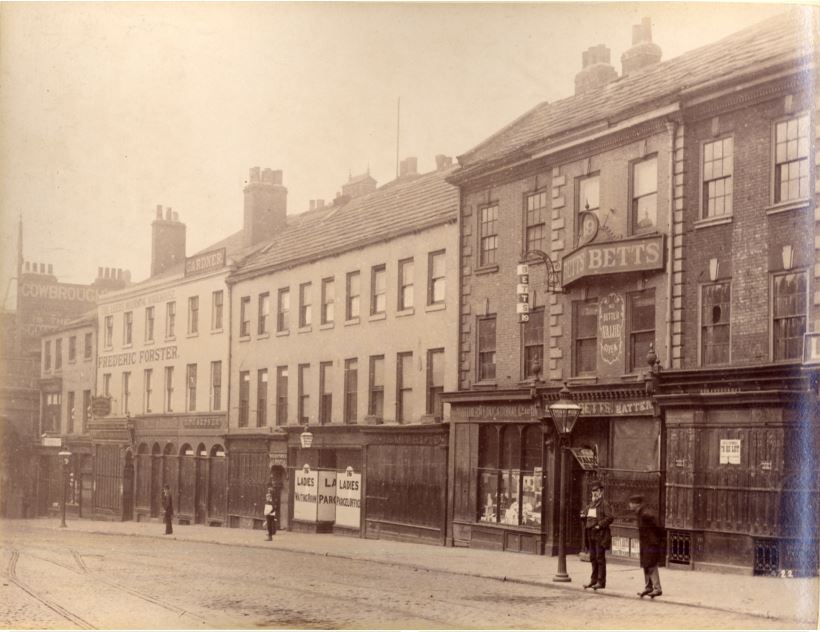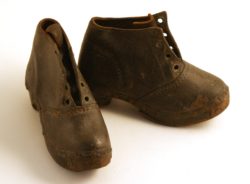Remembrance at Abbey House Museum

Frederic Forster’s Mourning Warehouse, Lower Briggate, Leeds, founded 1849. Photo c. 1870-1890, possibly taken by J Wormald. © Leeds Museums and Galleries.
Guest blog from Partick Bourne, Assistant Community Curator at Abbey House Museum and Kirkstall Abbey, Leeds
I have an interest in the material culture around death and dying, and have previously explored ‘Death and Disease in Victorian Leeds’ in the form of Study Days at Abbey House Museum and Leeds City Museum, which ran in 2015-2017. These study days are a chance for visitors to look at collections not normally on display. In the collections of Leeds Museums and Galleries are a range of range of items attesting to the rich history of Victorian mourning ritual, from paper ephemera such as mourning cards to commemorative items like mourning jewellery made of hair or Whitby jet, and the mourning wear itself which would have been worn by the deceased’s widow and family.
As a museum of social history, Abbey House Museum was felt to be an ideal venue to host a display around the topic of remembrance (you can read more about our plans as they evolve here). Our permanent Victorian street display includes the shop front of a Mourning Warehouse, based on Frederic Forster’s Mourning Warehouse, which was founded in 1841 and stood on Lower Briggate. There is an imitation Victorian undertakers in our back street, including a funeral bier and brass coffin decorations. Upstairs, a section of our Childhood Gallery deals with infant mortality – 1 in 5 children didn’t make their 1st birthday in the 19th century, and thus it was an ever present issue. In the midst of life, the Victorians truly were in death. Mourning brooches and personal effects also appear in the window of our Victorian pawnbrokers display.
All of the Victorian shop and business displays at Abbey House Museum have been named after real Leeds people .The toys and fancy goods shop is called Vassalli Pelegrino. The real person was a Swiss toy maker, and many of his family - including some very young children - were buried in the Leeds General Cemetery (St George’s Fields), now part of the University grounds. Many graves are gone but the Pellegrino gravestone still survives.
I am interested in how the very public way of showing grief which was part of Victorian culture changed in the first half of the 20th century to a more private, individual and less conspicuous methods, and why this happened. Our collections do include some personal items commemorating local people in the early 20th century, including some from those who served in the two world wars. However there are gaps, and the tapering away of an institutionalised mourning culture at some point in the early 20th century does seem to dovetail with the coming of a more private way of grieving and remembering. Have everyday objects become more important than purpose made mourning objects since the Victorian era? On the one hand, the early 20th century witnessed two horrific world wars and mass commemoration on an unprecedented scale. Yet on the other hand the practice of being ‘in mourning’ largely went out of favour. Of course, this varied across communities and cultures, and we are interested in the range of different ways people choose to remember (or forget) today.
We also want to draw out the hidden stories in some of our more interesting objects. Sometimes everyday items can take on a new and different significance once invested with personal stories. One very poignant but unassuming object on display at Abbey House Museum is a pair of children’s clogs, dating from 1903, which originally had red laces but are now unlaced. The story behind them, told by the donor, is that her mother was due to have a baby boy so, as a joke, relatives sent the father the clogs. However, tragedy struck as the baby died before the clogs arrived and the mother died shortly after. The father hung these clogs in his bedroom to remind him of his wife and child.

Pair of children’s clogs (1903), donated by Miss H Dawson. © Leeds Museums and Galleries.
Death and loss touch us all, and in exploring remembrance as a topic, we wish to ask people in Leeds today how they choose to remember those that have passed, whether it is through objects, space or actions.
My post is funded by Arts Council England, and my remit is to try and reach out to engage audiences and communities who would not normally necessarily choose to access museums for a variety of reasons. My role includes taking museum objects to local groups for reminiscence and handling, especially to older people. In the past I have co-curated exhibitions with local groups on topics such as growing up in different decades, and protests in Leeds today. I have also worked with different faith groups to host an event at Kirkstall Abbey in Interfaith Week. In the months ahead we plan to chat to a range of people of all ages and backgrounds in the hope of including a variety of voices and experiences that will help build a picture of Remembrance in modern Leeds, and which will sit alongside the objects from 1900-1950.
If you have any ideas about how the dead have been remembered through stories, actions, objects or places, please leave a comment below.
